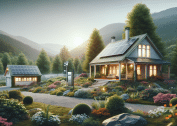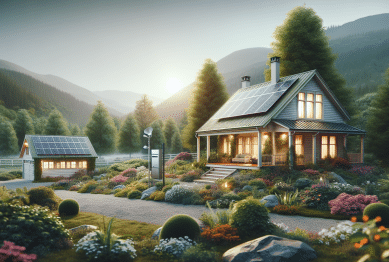Curious about creating a vibrant, water-wise garden that thrives with less effort? Discover expert strategies for low-water landscaping, including plant choices, soil tips, and sustainable design techniques to boost curb appeal and save resources. Take a closer look at how you can cultivate beauty and reduce maintenance outdoors.
Understanding Low-Water Landscaping Benefits
Low-water landscaping, often called xeriscaping, is gaining attention for its ability to blend beauty with sustainability. This gardening style revolves around using drought-resistant plants and efficient irrigation systems, lowering the demand for water and daily upkeep. With more communities experiencing water restrictions, the shift to low-water gardens offers a practical and stylish solution for homeowners wanting attractive outdoor spaces that require fewer resources.
Aside from conserving water, low-water gardens can reduce lawn care expenses and the need for fertilizers or pesticides. Many popular garden plants, like succulents, ornamental grasses, and native shrubs, naturally require less water while offering diverse textures and colors. The result is an appealing landscape that supports local pollinators and wildlife. Over time, these resilient gardens adapt to seasonal changes and provide year-round visual interest.
Low-water landscaping also encourages smarter garden design. By grouping plants with similar watering needs, homeowners can create zones, optimizing irrigation efficiency and minimizing waste. In the long run, this approach promotes environmental responsibility without sacrificing style or comfort. As climate patterns evolve, water-efficient gardens stand out as a wise investment in both aesthetics and ecological health (https://www.epa.gov/watersense/water-efficient-landscaping).
Planning Your Water-Efficient Garden Layout
Every successful low-water landscape begins with a thoughtful plan. Start by evaluating your existing yard conditions: sun exposure, slope, soil type, and areas that collect or drain water quickly. Mapping these features helps you position plants where they will naturally thrive. For example, drought-tolerant flowers and shrubs tend to perform best in sunny, well-drained sections, while native grasses may flourish in partially shaded spots.
Dividing your garden into hydrozones is another key planning technique. Grouping similar plants with matched water requirements prevents overwatering and supports efficient soil moisture management. Use hardscape elements like gravel, rocks, or pavers to define paths and reduce weed growth. These additions minimize water runoff while adding visual interest and structure to your design.
Planning also includes choosing a suitable irrigation method. Drip irrigation systems and soaker hoses deliver water directly to plant roots, minimizing evaporation and keeping weed growth in check. Automating watering on a consistent schedule ensures optimal soil health. With a detailed garden layout and watering plan, you set the stage for a more sustainable, easier-to-maintain garden (https://extension.psu.edu/planning-and-designing-the-home-landscape).
Choosing Drought-Tolerant Plants and Ground Covers
The heart of any low-water landscape lies in plant selection. Hardy, drought-tolerant varieties shine in water-wise gardens. Popular options include lavender, rosemary, succulents like agave and sedum, and ornamental grasses that withstand dry spells with minimal fuss. Many native flowering perennials, such as coneflowers and yarrow, thrive without frequent irrigation and attract pollinators.
Ground covers also play a crucial role by shading soil, reducing evaporation, and preventing erosion. Clover, creeping thyme, and ice plant are excellent alternatives to conventional grass lawns, offering color and resilience with low water needs. Mixing heights and textures adds dimension, while deep-rooted natives help stabilize areas that might otherwise become patchy or barren during drought (https://xerces.org/publications/guidelines/xerces-society-guidelines-for-pollinator-friendly-landscaping).
It’s worth researching which drought-resistant plants are native to your region. These options usually require less water, adapt to local soil conditions, and need little attention once established. By carefully curating your plant palette, you cultivate a resilient, lively garden with year-round interest. Seek guidance from local botanical gardens or extension offices for the most reliable selections in your area.
Soil Preparation and Mulching Essentials
Soil quality is pivotal in water-wise gardening. Improving soil structure makes a dramatic difference in plant health and moisture retention. Many drought-tolerant species flourish best in well-drained soil amended with organic matter like compost or aged manure. Test the pH and drainage rates before planting; these steps prevent root rot and nutrient imbalance.
Mulching is another essential low-water landscaping technique. Organic mulches such as bark chips, straw, or leaf litter condition soil and keep roots cool while drastically reducing evaporation. Mulches also create a barrier against weeds, helping plants compete effectively for limited water. Note that mulch depth affects moisture levels; two to three inches is often ideal for most landscape beds.
Soil amendment and mulching work best together. They encourage healthy microbial activity, making nutrients more available to roots. Periodically replenish organic mulches to maintain coverage as they break down. Inorganic mulches, like gravel or stone, provide lasting weed suppression without contributing organic matter, making them suitable for pathways or rock gardens (https://hgic.clemson.edu/factsheet/mulch).
Sustainable Irrigation Practices and Smart Water Savings
Irrigation choices can make or break low-water landscaping efforts. Opt for systems designed for minimal waste. Drip irrigation stands out for its precision, channeling water directly to plant roots with little loss. This method not only conserves water but encourages deeper root systems, increasing drought resistance and garden longevity.
Smart irrigation controllers, now widely available, tailor watering to current weather and plant needs. These devices respond to rain, temperature, and soil moisture metrics, maximizing water savings. Adjusting watering schedules to early mornings or evenings further limits evaporation. Regular system checkups prevent clogs and leaks, sustaining system efficiency year-round.
Rainwater harvesting offers additional possibilities. Collection barrels and cisterns store rain that can be redistributed through the garden. This strategy reduces reliance on municipal water and meets local water restrictions where applicable. Sustainable irrigation practices not only lower bills but also foster better plant health, building a greener garden with every drop (https://www.fs.usda.gov/Internet/FSE_DOCUMENTS/fseprd742022.pdf).
Design Ideas to Boost Curb Appeal and Reduce Maintenance
Beyond sustainability, low-water landscaping brings fresh design opportunities. Consider geometric patterns with hardscape materials or cluster drought-tolerant plants in raised beds for visual flow. Layered garden beds combine height and texture, adding interest without demanding extra care. Decorative gravel, boulders, and reclaimed wood elements can further elevate your home’s outdoor style, merging aesthetics with practicality.
Selecting multi-season plants ensures your garden looks lively all year. Evergreen shrubs, ornamental grasses, and flowering natives provide constant color, even during dry months. Use rock gardens or dry creek beds to manage runoff and highlight pathways, blending function and design. Fewer thirsty lawn patches mean less mowing, edging, and fertilizing, giving you more time to enjoy your outdoor sanctuary.
Finishing touches can make a big difference. Solar lighting, bird baths, and seating areas invite you to appreciate your garden’s tranquility after sunset. With the right mix of function and creativity, water-wise landscaping transforms not just your yard, but your whole approach to living outdoors. Explore the changing possibilities each season brings to maintain enthusiasm and enjoyment (https://www.garden.org/yard/low-water.shtml).
References
1. U.S. Environmental Protection Agency. (n.d.). Water-Efficient Landscaping. Retrieved from https://www.epa.gov/watersense/water-efficient-landscaping
2. Penn State Extension. (n.d.). Planning and Designing the Home Landscape. Retrieved from https://extension.psu.edu/planning-and-designing-the-home-landscape
3. Xerces Society. (n.d.). Xerces Society Guidelines for Pollinator-Friendly Landscaping. Retrieved from https://xerces.org/publications/guidelines/xerces-society-guidelines-for-pollinator-friendly-landscaping
4. Clemson University Cooperative Extension. (n.d.). Mulch. Retrieved from https://hgic.clemson.edu/factsheet/mulch
5. USDA Forest Service. (2020). Rainwater Harvesting for Homeowners. Retrieved from https://www.fs.usda.gov/Internet/FSE_DOCUMENTS/fseprd742022.pdf
6. National Gardening Association. (n.d.). Low-Water Yard Ideas. Retrieved from https://www.garden.org/yard/low-water.shtml









